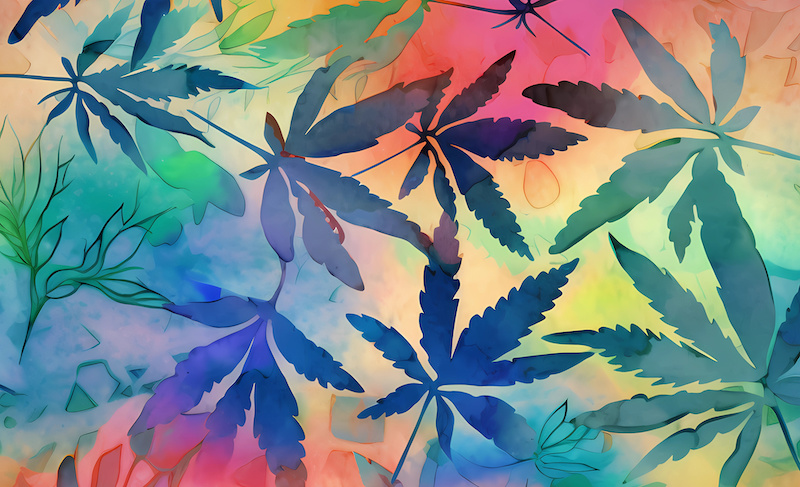Features
‘Bud’ to ‘trichome’: A glossary of cannabis terms
Published on April 5, 2024 by oz. staff
 Photo: Adobe stock/the oz.
Photo: Adobe stock/the oz. If it feels like cannabis has its own language, that’s because it does. Here is a glossary of cannabis terms you may come across while navigating weed.
Bud, or Flower
The bud, or flower, of the mature cannabis plant is the main part of the plant that’s smoked, vaped, or processed as it contains the highest concentration of cannabinoids in the plant, including THC and CBD.
Cannabinoid
Groups of structurally-related chemical compounds in the cannabis plant, some of which bind and interact with cannabinoid receptors distributed throughout the body. Cannabinoids are what cause the plant’s effects.
CBD
Cannabidiol, known as CBD, is one of dozens of molecules called cannabinoids found in the cannabis plant. CBD has become known for its medical benefits. Unlike THC, CBD has no psychoactive effects.
Concentrate
Highly potent forms of cannabis made by extracting cannabinoids from cannabis plants. There are a number of different concentrates, including oil, rosin, hash, wax, and shatter, that are made by pressing or processing cannabis. Concentrates are often vaped, dabbed, or smoked.
Crunk
A cross between chronic and drunk, it means to be high and drunk at the same time.
Dab/dabbing
A dab is a small amount of concentrate, like hash oil or shatter. Consuming it is called “dabbing,” which is done with a heat and a rig to make vapor, which is inhaled.
Edible
Food that’s infused with cannabis.
Extraction
The process of making concentrates. Some extraction methods use chemicals such as alcohol, carbon dioxide, and butane.
Greening out
Consuming too much weed is called greening out (which comes from the booze term blacking out). It’s associated with different symptoms for different people: nausea, dizziness, sweats, confusion, not feeling like you can move.
Hemp
A plant in the same species as cannabis, but with very low levels of THC. Hemp plants have been used for centuries to make rope, cloth, and paper.
Hash
A form of concentrate made from compressed trichomes, a.k.a. kief.
Illicit cannabis
Also known as grey market weed, illicit cannabis is obtained from a source that’s not regulated.
Kief
Dust that falls from dried flower, which is actually trichomes.
Larf
Possibly one of the most fun words to say out loud, larf is small, immature buds that haven’t reached their full potential. Often, larfy buds are from the bottom of the plant where there wasn’t enough light.
Legacy
In cannabis, legacy refers to a person or company that worked in weed before legalization.
Minor Cannabinoids
Aside from the big two, THC and CBD, there are numerous minor cannabinoids that come from the cannabis plant. Some have their own distinct effects. Minor cannabinoids are increasingly being featured in products, including CBG, CBN, and CBC.
Rosin
Cannabis extract that’s made without using solvents or chemicals, usually produced through pressure and heat.
Shatter
It looks like caramel or toffee that could be shattered like glass. It’s a brittle concentrate used in dabbing.
Strain, or Cultivar
Through years of cross breeding, cannabis plants come in an increasingly wide variety. In the legal cannabis market, the name is not usually the strain—but the strain is increasingly listed on the label. Examples include Northern Lights, OG Kush, Green Crack, etc.
Terpenes
Terpenes are aromatic metabolites found in the oils of all plants. In cannabis, research has shown that they help give different strains their smell, taste and effect.
THC
The abbreviation for tetrahydrocannabinol, a crystalline compound that is the main active ingredient of cannabis and responsible for the psychoactive effects. It’s also known as Delta-9-tetrahydrocannabinol.
Trichomes
These are the glands, or hairs, on a cannabis plant that carry the majority of the THC and CBD in the plant. Viewed under a microscope, they look like water droplets.
—
Originally published on Jan. 20, 2019.
Leave a comment on our Facebook page.
© Copyright 2024 Okanagan Z. | About the oz.
Report a Typo or Inaccuracy
We strive to avoid typos and inaccuracies. However, on occasion we make mistakes. We value your contributions and help in correcting them.